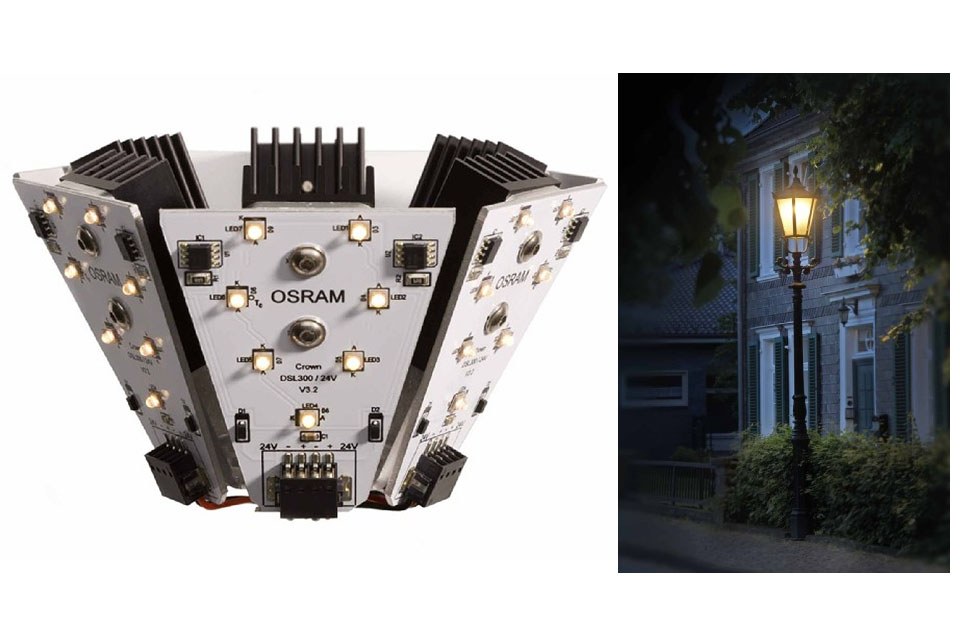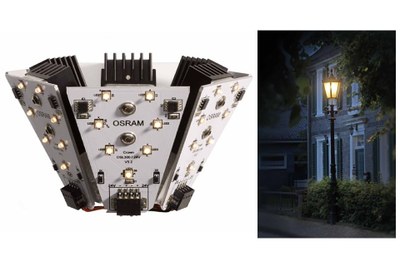Osram Offers DSL LED Module to Refurbish Historic Street Luminaires
Osram is now offering the Decorative Street Lighting (DSL) LED refurbishing module for historic street luminaires. The module can be used independently of manufacturer for a wide variety of luminaires and is prepared upon request so that fitting is as simple as replacing lamps or sockets. The DSL cuts energy consumption of luminaires previously operated with mercury vapour discharge lamps by at least 60 per cent, and upgrading costs less than half of a new LED installation. In total, street and park lighting are responsible for around 40% of overall energy costs for many municipal authorities.
The energetic refurbishment of street lighting is currently a hot topic for local authorities, and according to a recently published survey, street and park lighting consists of approximately 40% of total electricity costs for many municipalities. On the background of global hikes in energy prices and tight public budgets, LED is an important method of leverage in reducing such costs. In addition, the European Union's Eco-Design guideline will in the future make sure that several lamp types are no longer available. The first choice when upgrading street lighting are LEDs. During operation these consume at least 60% less electricity than many light sources still in use and ensure especially long maintenance intervals. Standardised refurbishment modules are available for many models that enable luminaires to be updated from classic technology to LED, but such standard solutions remain unavailable for heritage luminaires. It's here that the DSL provides support: the council sends a luminaire to Osram. The lighting experts adapt a construction kit consisting of an LED module and mounting plate specifically to the luminaire, and an employee from the town's works department is then able to install this on-site, simply and almost without use of tools.
The benefits of upgrading are obvious: with use of Oslon SSL, the latest generation of Osram LEDs, the DSL consumes at least 60% less energy than traditional lamps and is also more than twice as durable. The level of colour rendering even satisfies the demands of office lighting, and the times of dimly-lit, pale roads are a thing of the past. DSL also enables more targeted control of light compared to classic lighting. If, for example along a certain road section, the rear-illuminating third of the LEDs is done without, not only energy is saved but disturbing "light spill" behind the luminaires into the living rooms of residents need no longer be put up with. The integration of modern control units with intelligent light management ensures further energy savings. "AstroDIM" for example enables luminaires to be dimmed completely self-sufficiently without use of a corresponding control line. In this way, between midnight and the early morning hours, lighting can be adapted to lower volumes of traffic to achieve supplementary energy savings.
About Osram:
Osram AG (Munich, Germany) is a wholly-owned subsidiary of Siemens AG and one of the two leading light manufacturers in the world. In fiscal year 2011 (ended September 30, 2011), it generated revenue of about 5 billion Euros. Osram is a high-tech company in the lighting sector and more than 70 percent of its revenue comes from energy efficient products. The company, which is very much internationally oriented, has around 41,000 employees worldwide, supplying customers in 150 countries from its 44 production sites in 16 countries (as of September 30, 2011). Additional information can be found in the internet at www.osram.com.


